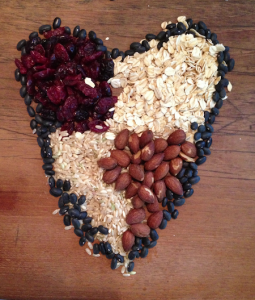In celebration of Heart Month, we’ve once again partnered with Rosanna, Inc. Be sure to check out Rosanna’s post about integrating touch into our daily lives.
****
You have heard it before “Exercise and eating right are essential for your heart health.”
Typically, we associate heart disease with adults, but kids are susceptible, too.
Here are a handful of a few startling statistics from the American Heart Association’s “Heart Disease and Stroke Statistical Update 2013,” published in the American Heart Association journal, Circulation.
- More adults age 20 and over are obese (34.6 percent) than normal or underweight (31.8 percent); 68.2 percent are overweight or obese.
- Among children ages 2-19, 31.8 percent are overweight or obese.
- Thirty-two percent of adults report no aerobic activity; 17.7 percent of girls and 10 percent of boys, grades 9-12, report fewer than an hour of aerobic activity in the past week.
- 13.8 percent of adults have total cholesterol of 240 mg/dL or higher.
- Thirty-three percent of adults have high blood pressure; African-Americans have among the highest prevalence of high blood pressure (44 percent) worldwide.
- 8.3 percent of adults have diagnosed diabetes, and 8.2 percent have undiagnosed diabetes; 38.2 percent have pre-diabetes.
When it comes to eating the right foods, the greatest challenge is changing our current eating habits. And, as we all know, changing habits can be hard to do. However, once that change and you’ve worked hard it implementing it into you daily routine, then it becomes habit. . . . one you can stick with for the rest of your life.
February is the month of love, so why not give your heart a bit of love and add a few of these foods into your diet .
We’ve also included some great tasting recipes that incorporate these foods – recipes that are also quick and easy to make. Who knows, your old habits may be easier to break than you thought.
1. Eat your Greens
Remember, a diet rich in green , leafy vegetables is a great way to boost the health of your heart. Spinach is rich in fiber, lutein, potassium, folate and surely boosts your heart health. It is highly recommended by the physicians and those who eat regularly are at a lesser risk for heart disease, but there are lots of other greens that can help keep your heart healthy.
2. Whole Grains Goodness
It is well documented that those who eat whole grains regularly have a lower risk of obesity as well as lower cholesterol levels. A great source of fiber – as well as other nutrients, whole grains help regulate blood pressure and promote heart health.
It is recommended that you eat at least half of our grains as whole grains,
Grains such as wheat, corn, rice, oats, barley, quinoa, sorghum, spelt and rye are all delicious whole grains that offer essential nutrients, and contribute to a healthy diet – a few include protein, dietary fiber, folic acid, and magnesium. For more information on grains, check out the Whole Grains Council website.
Bulgur Salad with Feta and Pine Nuts
Oatmeal Coconut Raspberry Bars
3. Berries
Berries are low in calories, yet high in fiber. They also contain essential vitamins and minerals to keep your body functioning normally.
One cup of strawberries contains over 100 milligrams of vitamin C, almost as much as a cup of orange juice. You need vitamin C for immune system function and for strong connective tissue. Strawberries also add a bit of calcium, magnesium, folate and potassium and have only 53 calories.
As a whole, berries contain phytochemicals and flavonoids that may help to prevent some forms of cancer. For instance, one cup of strawberries contain nearly as much vitamin C as in a cup of orange juice; cranberries and blueberries contain a substance that may prevent bladder infections; and blueberries and raspberries also contain lutein, which is important for healthy vision.
Cranberry Compote with Ginger and Molasses
Viennese Pancakes with Wild Blueberries
4. Good Fats
In an effort to reduce the amount of saturated and trans fats in your diet, take a look at the solid fats such as butter, margarine and shortening, you consume. As well, trim fats off of your meats, or choosing leaner cuts.
Another way to cut your trans fat intake is by cutting your use of packaged foods – many of which contain trans fats, even if they are labeled as ‘reduced fat.’ As a tip, if you see the words ‘partially hydrogenated’ on the ingredient list, you’re probably getting some trans fats.
As an alternative, choose monounsaturated fats, that can be found in olive or canola oil; or polyunsaturated fats, which are found in seeds and nuts. Remember, all fats are high in calories, so consume them with moderation in mind.
Lemon and Olive Oil Salad Dressing
5.Legumes
Beans are jam-packed with omega 3 fatty acids, soluble fiber, folate, calcium and more. Adding them to your diet is a great way to improve your health, and can help prevent many of the most critical issues facing us today, heart disease included. Beans provide sustained energy and can help promote satiety, meaning you’ll eat fewer calories, making the most of the calories you eat.






